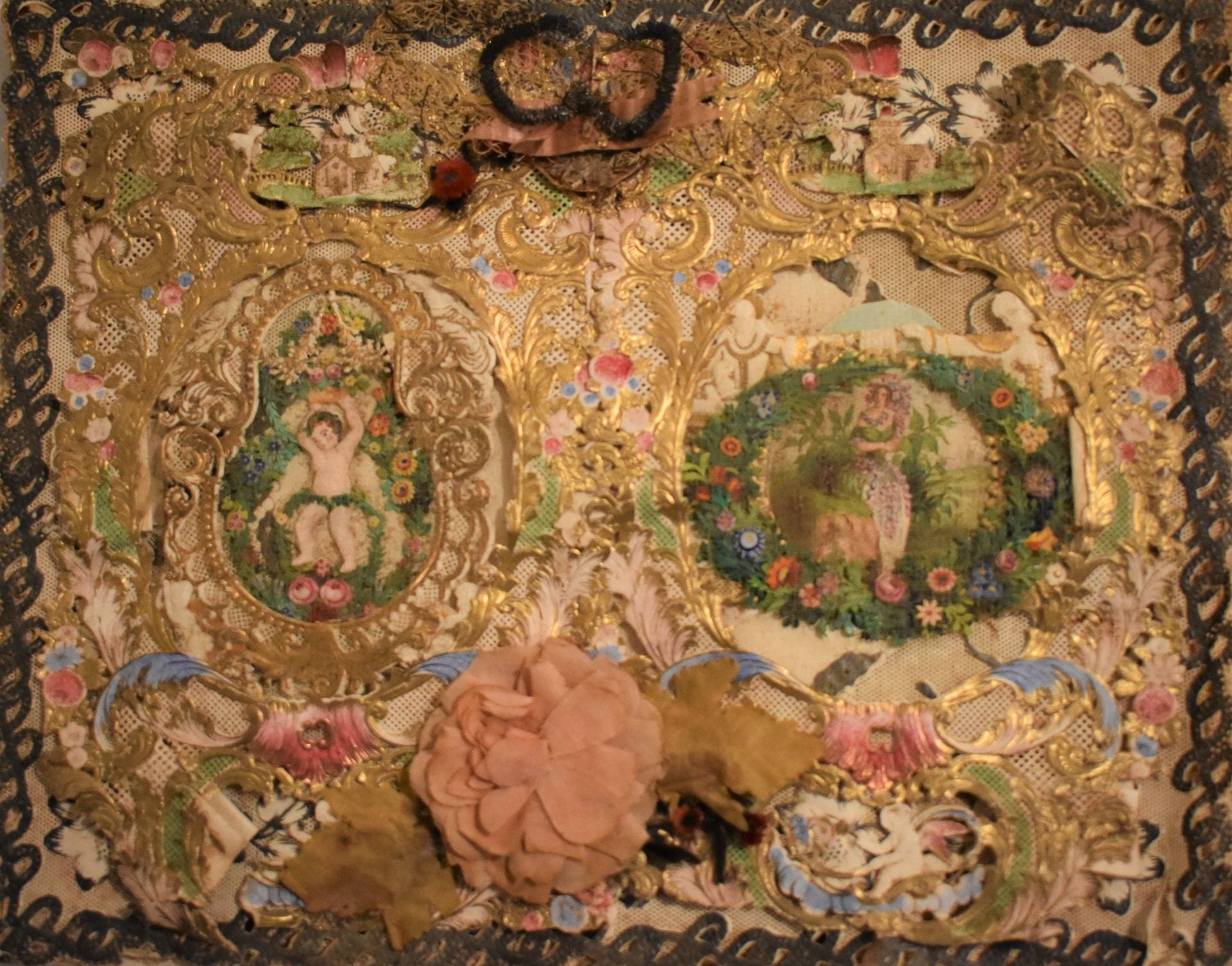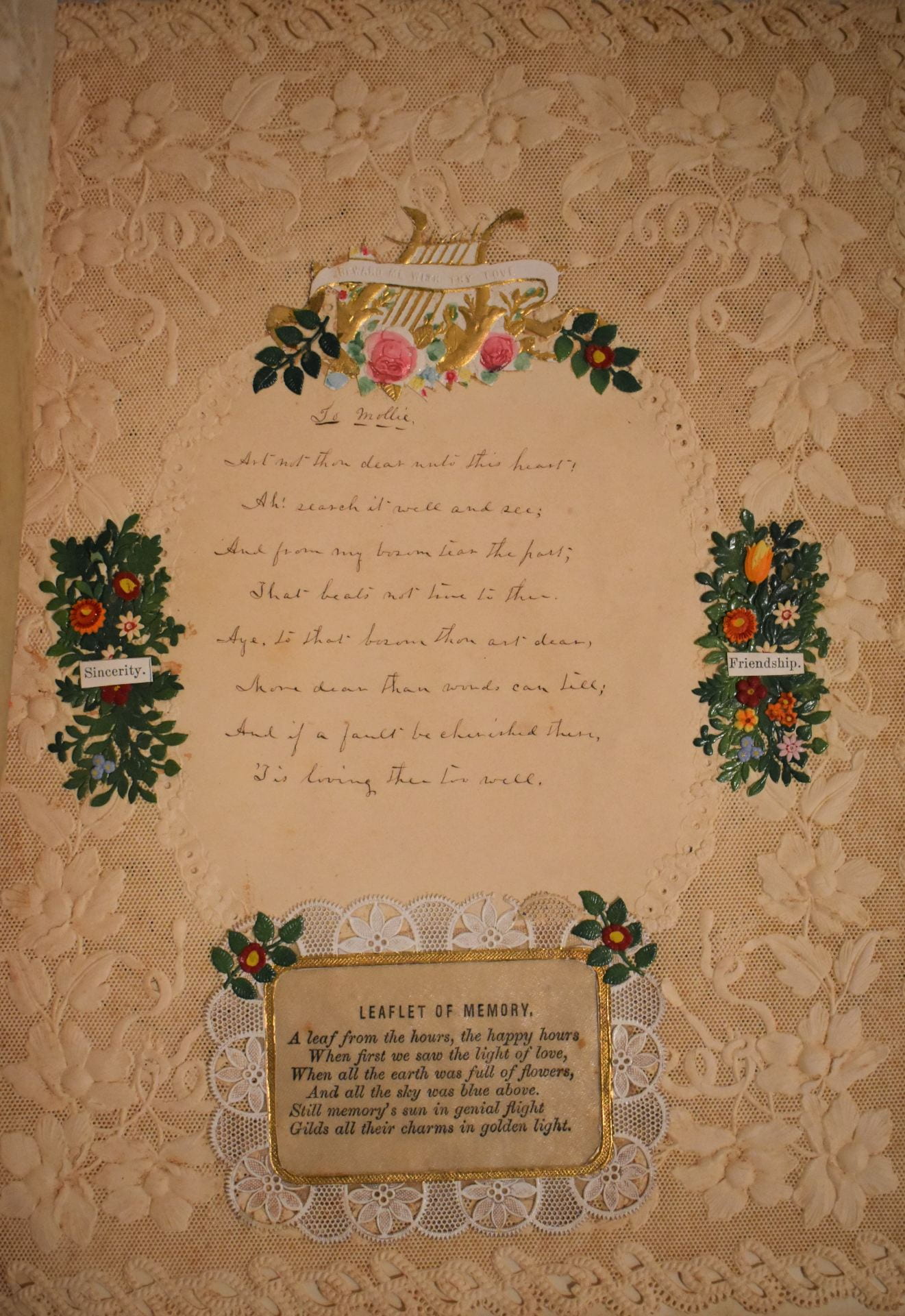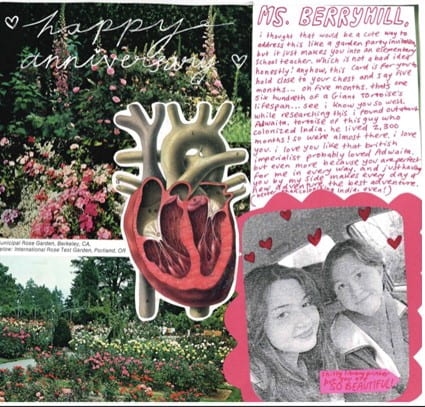Greeting Cards
Jules Prown’s article “Mind in Matter: An Introduction to Material Culture Theory and Method” outlines the three stages of object analysis: description, deduction, and speculation (7). This methodology allows for a thorough examination of an object and its larger cultural context. Using Prown’s investigative stages, I have analyzed two objects for this exhibit: a Victorian greeting card, and a personal 21st century anniversary card. The following research and interpretations serve to help an audience understand the objects’ background and context in the world of material culture. Comparing and contrasting these different cards will help to answer questions about how expressions of care and identity have shifted over time: How do we show others we care about them? How has formality played a role in expressions of care? Does the construction of a card— handmade or mass-produced— change its context.
The description stage of Prown’s object analysis consists of “recording the internal evidence of the object itself,” (7). The Victorian greeting card is intricately crafted out of lace and dyed doilies, thin layers of gilded paper, dried flowers, and plain paper backgrounds used to display text. Additionally, gold leaf filigree is used to border poems and delicate paintings within the card. As for the card’s structure, there are three main pages of poems and writing, bracketed by two highly intricate covers. The subject matter of the card features rhyming, printed poems and handwritten notes scrawled in looping cursive. Iconography includes floral imagery, cherubic figures, harps, colorful dyed flowers, and beautiful, painted ladies. Standout printed text includes two white banners with “Friendship” and “Sincerity” printed on them. Another main visual aspect of the card are the silvery, flowered gates on the card’s cover— perhaps these represent the “gates of Heaven” with winged cherubs sitting atop them, or some entrance to a manor (there is additional house imagery on the other cover of the card). Collectively, the card prominently features religious and flowery imagery, reflecting how religiosity tied into expressions of affection when the card was produced.


The personal, 21st century anniversary card is a two-sided piece of cardstock featuring magazine pictures, photographs, felt stickers, and a block of handwritten text. The card prominently features floral imagery, similarly to the Victorian card. The card has a black and white photograph of my girlfriend and I, with a small pink banner overlaying it. Iconography includes wildlife imagery, rose gardens, hearts (both anatomical and cartoon) and features shades of pink, red, and green.


Prown’s deduction stage is outlined as “interpreting the interaction between object and perceiver,” (7). This phase centers around engaging with the object and analyzing what an audience’s reaction to the object might be. Additionally, the original use and context of the object is taken into consideration. The Victorian greeting card is extremely delicate, likely a consequence of time and weathering. The recipient of the card (it is addressed to “Mollie”) took evident care of the object, seeing as the fine layers of the card are mostly intact, with no notable rips or tears. This greeting card’s purpose was likely to express affection towards the recipient. The main contents of the card are centered around praise, friendship, and earnestness; the poems in the card sing praise of “Mollie’s” purity and beauty. My immediate emotional reaction to the object is a feeling of awe— the card is a stunning work of craftsmanship and paper art. An audience’s response might be similar to mine— the card’s intricacy inspires wonder.
The 21st century anniversary card is sturdy from the cardstock backing, and its layers are held together with a strong craft glue. However, the text was produced using gel pens, which is a medium notable for its impermanent nature as it is easily rubbed off or worn down. The card is addressed to my girlfriend, the recipient, and its contents center around celebrating our anniversary and expressions of affection. This card’s purpose was to act as a tangible representation of love towards the recipient, and additionally acts as an expression of my emotions through a paper medium. To an outside audience, the card might come across as flowery or overly sincere. The text is informal and features inside jokes and irreverent humor, which might be difficult for an audience to understand the context of. My emotional reaction to the object is both embarrassment and pride— as I am the maker of the card, seeing my own vulnerability displayed so openly is a frightening prospect. However, considering all life stages of the card: painstakingly collaging the pieces together, giving the card to the recipient, seeing her reaction to my honesty— remind me of the emotional impact the card had, giving me a feeling of pride.
Finally, the speculation phase of Prown’s object analysis is comprised of “framing hypotheses and questions that lead out from the object to further external evidence for research and resolution,” (7). My main research question surrounding this object was to investigate how larger cultural shifts led to an environment where a card like this could be created. First, I had to date the greeting card itself to understand what cultural background to research. With no maker’s mark, and poems that seemed to be one of a kind, this was a difficult task. However, I found multiple Victorian Valentine’s day cards and correspondence that were made in an incredibly similar style: lace doilies, gold leaf filigree, similar font styles, and cherubs/religious imagery. Cards from the Bridgeman Art Library archive feature banners with “Friendship” and “Love, Innocence” printed on them, and are from England, 1870. Even more cards featured in collections like the Smithsonian’s Norcross Greeting Card Collection and the Wisconsin Historical Society’s collection highlight a similar style to the card I analyzed; these collections date their similarly styled cards from around the 1870s to the turn of the century. ()
Thus, the greeting card I am analyzing is perhaps a product of the 19th century greeting card boom in England, or is a replica of that style from the United States. In 19th century England, several cultural shifts and trends occurred to produce a major influx in card-giving and distribution. In Annebella Pollen’s article on Victorian Valentine’s trends, she cites “new forms of industrial print production, the growth of literacy and the spread of the postal system” as the catalyst for the rise in greeting card popularity. Cards from this era could be both affectionate or mean-spirited, highlighting how Victorian card’s could be both formal and informal. When further analyzing these developments, the postal system plays a large role. Karin Khoeler’s article in Victorian Literature and Culture dissecting Victorian correspondence asserts that it was “the 1840 introduction of Rowland Hill’s penny post in Britain, alongside concomitant advances in American and European postal infrastructure, which led to a veritable explosion in the exchange of valentines.” 19th century England saw rising literacy rates and a more accessible mail system combined with an already industry driven culture; these larger cultural shifts created the perfect climate for the rise in correspondence popularity.
Print culture then echoed throughout the world— Esther Howland, the “Mother of the American Valentine” created the New England Valentine Company in the mid-1800s (Wisconsin Historical Society). This development brought mass-produced greeting cards to America, peaking in popularity until 1942, when paper shortages stemming from World War 2 impacted the industry (Wisconsin Historical Society). Because of these developments in the United States, mass-produced cards quickly became the standard. When analyzing the shifting role of greeting cards, one would be amiss to not mention Hallmark. Author Emily West writes in the Journal of Consumer Culture: “Hallmark, located in Kansas City, MO, is a middle America, ‘Heartland’ brand, and promotes itself as such. While Hallmark is a tremendously successful company, its success also makes it a cultural target, especially for its ‘middleness,’” (4). She goes on to describe how Hallmark controls upwards of 50% of the greeting card market (West 4). Hallmark’s position as a middle-class, Midwestern brand gives it an air of sanitized moderateness. The brand’s success and control over the greeting card industry illustrates how the rise in mass-produced cards has become the norm in American culture. Contrasted with the delicate nature of Victorian era English cards, modern day cards have a much less formal construction. Additionally, one must consider how mass-produced cards are considered to be less personal. Comparing the modern, handmade anniversary card with Hallmark’s particular brand of mass-produced cards reveals how heart and personality play a role in how genuine a card comes across. Furthermore, the personalization of cards (handwritten notes, inside jokes) also lends to a card’s earnestness. Whether mass-produced or handmade, humor still plays an important role. Annebella Pollen writes about comic, sometimes vitriolic Victorian Valentine’s cards that mirror modern day, mean-spirited greeting cards. This is mirrored in my 21st century anniversary card; the presence of humor and light teasing when expressing care is a concept that has stayed prevalent throughout the history of greeting cards. My theory is that cultural values of the time period are reflected by greeting cards. Victorian England placed emphasis on sentimentality, beauty, prose and decadence, while modern U.S. cards are more sleekly designed, and are often based solely around a punchline.
Speculating about the 21st century anniversary card forced me to consider my own motivations behind the card and what cultural conditions led me to make it. Significantly less formal than the Victorian greeting card, my card reflects my love for collage art as a medium. Collage art is a popular medium in the social media circles I participate in, and its popularity online inspired me to begin making text-based collage art of my own. I then began a collection of vintage books with which I collaged. The magazine photographs are taken from a 1970s National Geographic and a manual on proper rose gardening techniques from 1978. I felt that these images illustrated my personal feelings towards my partner in a nonverbal manner. Thus, my fascination with collage was born out of my usage of social media, meaning the card would not have been produced, or produced in the same way, if I had been in a different time period.
To conclude this analysis, it is important to note how these cards convey identity. In the modern sphere, Emily West posits how cards illustrate one’s personality: “When people send cards they are declaring not only ‘I like this,’ but ‘This represents me’ and even ‘I mean this,’ because cards are representations of the self,”(2). In the Victorian card, the handwritten sections are tender and flowery, which lead the audience to conclude the card-maker must have had a strong affection towards the recipient. Additionally, the 21st century reveals a similar intimacy, illustrating how expressions of care can be timeless. Vulnerability can be intensely universalizing, and analyzing these examples of material culture from disparate worlds helps to illuminate that.
Bibliography
Prown, Jules. “Mind in Matter: An Introduction to Material Culture Theory and Method.” Winterthur Portfolio, Vol. 17, No. 1 (Spring, 1982): 1-16.
Friendship, Valentine card, c.1870 (colour litho on paper).” In Bridgeman Images: Cultural Collection, edited by Bridgeman Images. Bridgeman, 2014. https://go.openathens.net/redirector/uark.edu?url=https%3A%2F%2Fsearch.credoreference.com%2Fcontent%2Fentry%2Fbridgemancul%2Ffriendship_valentine_card_c_1870_colour_litho_on_paper%2F0%3FinstitutionId%3D5281
“Love, Innocence, Valentine card, c.1870 (colour litho on paper).” In Bridgeman Images: Cultural Collection, edited by Bridgeman Images. Bridgeman, 2014. https://go.openathens.net/redirector/uark.edu?url=https%3A%2F%2Fsearch.credoreference.com%2Fcontent%2Fentry%2Fbridgemancul%2Flove_innocence_valentine_card_c_1870_colour_litho_on_paper%2F0%3FinstitutionId%3D5281
Norcross Greeting Card Collection. Smithsonian Online Virtual Archives. https://sova.si.edu/record/NMAH.AC.0058
Valentine’s Day Greeting Cards – Image Gallery Essay. Wisconsin Historical Society. https://www.wisconsinhistory.org/Records/Article/CS3880
Pollen, Annebella. “’The Valentine has fallen upon evil days’: Mocking Victorian valentines and the ambivalent laughter of the carnivalesque.” 2014. Early Popular Visual Culture.
Koehler, Karin. “VALENTINES AND THE VICTORIAN IMAGINATION: MARY BARTON AND FAR FROM THE MADDING CROWD.” June 2017. Victorian Literature and Culture.
West, Emily. “A taste for greeting cards: Distinction within a denigrated cultural form.” November 2010. Journal of Consumer Culture.